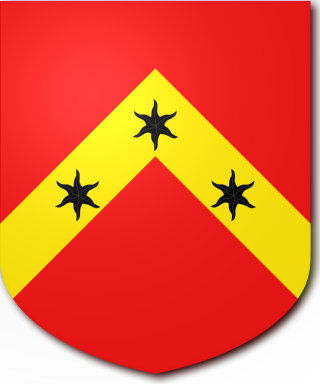There have been three baronetcies created for descendants of the ancient Lancashire family of Gerard.

There have been five baronetcies created for persons with the surname Barker, three in the Baronetage of England, one in the Baronetage of Great Britain and one in the Baronetage of the United Kingdom. All five creations are extinct.
There have been ten baronetcies created for persons with the surname Browne, six in the Baronetage of Great Britain, three in the Baronetage of Ireland and one in the Baronetage of Nova Scotia. Only one creation is extant as of 2010. Three of the creations were for members of the Browne family headed by the Viscount Montagu.

Sir John Baird, 2nd Baronet, of Newbyth of Newbyth, Haddington, was a Scottish politician who sat in the House of Commons from 1715 to 1722.
There have been six baronetcies created for persons with the surname Newton, three in the Baronetage of England, one in the Baronetage of Nova Scotia and two in the Baronetage of the United Kingdom.

The Hales Baronetcy, is a title in the Baronetage of England. There were three Hales baronetcies. The oldest was created in 1611 for Edward Hales. He was a member of a Kent family. The second was created in 1660 for Robert Hales, MP for Hythe 1659, also of a Kent family. The third was created in 1660 for John Hales of Coventry, co. Warwick.
There have been seven baronetcies created for persons with the surname Powell, five in the Baronetage of England and two in the Baronetage of the United Kingdom. Only one creation is extant as of 2007.

The Carr Baronetcy, of Sleaford in the County of Lincolnshire, is a title in the Baronetage of England. It was created on 29 June 1611 for Edward Carr who was Sheriff of Lincolnshire in 1614. The 3rd Baronet was Chancellor of the Duchy of Lancaster and a Member of Parliament for Lincolnshire in the House of Commons.

There have been five baronetcies created for members of the old established family of Peyton of Peyton Hall in the parish of Boxford in Suffolk, all of whom were descended from Sir Robert Peyton of Isleham in Cambridgeshire, grandson and heir of Thomas Peyton (1418–1484) of Isleham, twice Sheriff of Cambridgeshire and Huntingdonshire, in 1443 and 1453. All the baronetcies are extinct.
There have been two baronetcies created in the Baronetage of England for members of the Colepeper family of Kent and Sussex. Both are extinct.

The Hardres Baronetcy, of Hardres Court in the County of Kent, was a title in the Baronetage of England. It was created on 3 June 1642 for Sir Richard Hardres. The fourth Baronet, Sir William Hardres, was Member of Parliament for Kent and Canterbury. The title became extinct on the death of the fifth Baronet, William Hardres II, in 1764.
The Ellys Baronetcy, of Wyham in the County of Lincoln, was a title in the Baronetage of England.
There have been five baronetcies created for persons with the surname Wentworth, four in the Baronetage of England and one in the Baronetage of Great Britain. All creations are extinct.
The Wolstenholme Baronetcy, of London, was a title in the Baronetage of England. It was created on 10 January 1665 for John Wolstenholme, who had previously represented West Looe, Newport and Queenborough in Parliament. He had been heavily fined by the Parliamentarians for supporting the Royal cause during the Civil War. The third Baronet sat as Member of Parliament for Middlesex. The title became extinct on the death of the seventh Baronet in 1762.

Sir Robert Barnham, 1st Baronet of Boughton Monchelsea Place was an English politician who sat in the House of Commons from 1660 to 1679.

There have been two baronetcies created for persons with the surname More, both in the Baronetage of England. Both creations are extinct.
The Cordell Baronetcy, of Long Melford in the County of Suffolk, was a title in the Baronetage of England. It was created on 22 June 1660 for Robert Cordell, subsequently Member of Parliament for Sudbury. The second Baronet represented Sudbury and Suffolk in Parliament while the third Baronet briefly represented Sudbury. The title became extinct on the latter's death in 1704.
The Howe baronetcy, of Cold Barwick in the County of Wiltshire, was created in the Baronetage of England on 20 June 1660 for George Howe, Member of Parliament for Hindon 1660–1667. His son, Sir James Howe, 2nd Baronet, was also MP for Hindon. The baronetcy became extinct his death.

The Howe baronetcy, of Compton in the County of Gloucester, was created in the Baronetage of England on 22 September 1660 for John Howe, Member of Parliament for Gloucestershire in 1654–1655 and 1656–1658. His elder son Richard, the second baronet, was also an MP, as was his younger son John Grobham Howe. Sir Richard Grobham Howe, the third baronet, was MP for Tamworth, Cirencester and Wiltshire. Sir Emanuel Howe, 4th Baronet, became the 2nd Viscount Howe on the death of his father in 1713 and the baronetcy which he inherited in 1730 was merged with his viscountcy.

The Astley Baronetcy, of Patshull in the County of Stafford, was created in the Baronetage of England on 13 August 1662 for Richard Astley. The second Baronet represented Shrewsbury and Shropshire in the House of Commons. The title became extinct on his death in 1772.












